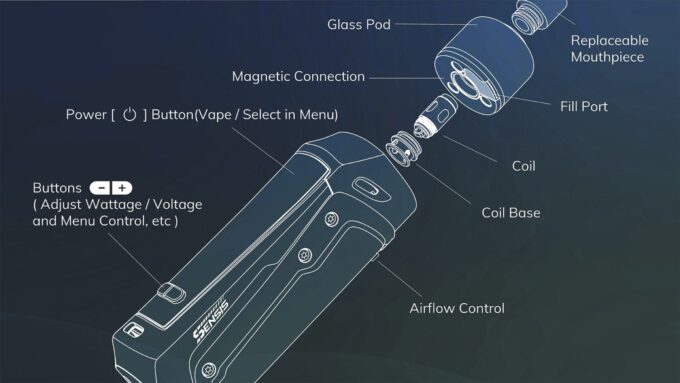Vaping has swiftly ascended to become one of today’s most prevalent trends, captivating a diverse audience with its allure. Astonishingly, a recent survey reveals that 30% of its enthusiasts are teens, engaging in vaping almost daily. [1] The reasons for this widespread appeal vary: some are enchanted by the plethora of flavors available, others find themselves influenced by their peers, and a significant number view it as a stepping stone towards quitting smoking. But what’s the secret behind this phenomenon that has captured the public’s imagination?
In this piece, we’re going to peel back the layers and dive deep into the world of e-cigarettes. We’ll explore how they’ve evolved, how they work, and what makes them tick. Plus, we’ve got a special treat for you — a sneak peek into an online store has the largest selection of top-shelf vape juice in the world.
The Evolution of Vapes
Before we delve into the BTS mechanics of vaping, let’s take a moment to appreciate its journey through time. It’s fascinating to see how vaping devices have transformed from their initial designs into the sleek, pocket-sized companions that many people carry today. To give you the full picture, we’ve put together a neat timeline below.
| Year | Key Development | Technical Details |
| 2003 | Invention in China by Hon Lik. | Developed the first commercial e-cigarette, utilizing ultrasonic technology to vaporize the liquid nicotine solution. |
| 2006-2007 | Entry into international markets. | Introduction of cartomizer systems, combining the atomizer and cartridge for a more efficient design. |
| 2010 | Surge in popularity; diversification in designs. | Emergence of second-generation devices, featuring larger batteries, cartomizers, and improved vapor production. |
| 2015 | Improvements in battery life and atomizer efficiency. | Introduction of sub-ohm vaping, allowing for lower resistance coils and enhanced flavor and vapor production. |
| 2020 | Introduction of smart features. | Integration of digital controls for temperature regulation, Bluetooth connectivity for device tracking, and OLED displays for user interface enhancements. |
| 2021 and Beyond | Rise in global users and evolving designs. | Development of pod-based systems with higher nicotine delivery efficiency, and continued focus on safety features like short-circuit and overheat protection. |
Types of Vapes Available in the Market

Source: innokin.com
Now that we’ve traced the evolution of modern vaping devices, it’s time to explore the variety available today. Each type caters to different preferences and lifestyles, offering unique experiences to vapers.
Tank Systems and Mods
These devices are the go-to choice for vaping aficionados. They offer unparalleled customization, allowing users to fine-tune everything from power output to flavor intensity. With their advanced features, tank systems and mods enable experienced vapers to experiment and personalize their vaping sessions. They often come with larger batteries and the ability to adjust wattage or voltage, providing a more robust and tailored experience.
Rechargeable Vapes
Embodying eco-conscious vaping, these devices feature either replaceable e-liquid cartridges or refillable tanks. They strike a balance between convenience and sustainability, making them a popular choice for environmentally aware users. The ability to recharge and reuse these devices reduces waste, while the option to switch cartridges or refill tanks offers versatility in flavors and nicotine strengths.
Disposable Vapes
The epitome of convenience, disposable vapes are designed for simplicity and ease of use. Ideal for beginners or those seeking a no-fuss vaping option, these single-use devices require no refilling or maintenance. They are perfect for on-the-go situations, travel, or as an introduction to vaping, providing a straightforward and hassle-free experience.
Stealth Vapes
For vapers who value discretion, stealth devices are the perfect solution. Compact and inconspicuous, they are designed to be used subtly, fitting seamlessly into daily life. These vapes are typically smaller in size, making them easy to conceal and use without drawing attention. Despite their small stature, they still deliver a satisfying vaping experience, ideal for those who prefer a low-profile approach to vaping.
6 Essential Parts of a vaping device

Source: innokin.com
Understanding the components of a vape is key to appreciating the technology behind it. Each part plays a specific role in delivering a seamless vaping experience.
1. The Battery
Often rechargeable, the battery is the heart of an e-cigarette. It provides the necessary energy to heat the atomizer. The battery’s capacity, usually measured in milliampere-hours (mAh), and its voltage output determine how long the device can operate before needing a recharge and how effectively it heats the e-liquid. Higher capacity batteries offer longer usage, while higher voltage batteries can produce more vapor.
2. The Logic Board, Integrated Circuit, and Firmware
These electronic components form the vape’s control center. The logic board and integrated circuit work together to manage power flow from the battery to the atomizer. Firmware, essentially the device’s software, controls various functions and safety features, such as regulating the power output, monitoring the battery’s charge level, and preventing overheating.
3. The Threading or Pod Contacts
This part of the vape ensures a stable and efficient connection between the battery and the atomizer or pod. In devices with threading, this involves a screw-like mechanism that securely attaches the components. In pod systems, contacts are typically magnetic or snap-fit, providing a convenient and reliable connection.
4. The Reservoir and Chimney

Source: vapessuperstore.com
The reservoir, also known as the tank or cartridge, stores the e-liquid. It’s typically made of glass or plastic and can vary in size. The chimney is a narrow tube that extends from the coil to the mouthpiece, guiding the vapor upwards when you inhale.
5. The Coil Assembly
Located within the tank, the coil assembly is where the e-liquid is transformed into vapor. It consists of a coil (a small piece of resistance wire) wrapped around a wicking material, usually cotton. When the device is turned on, the battery warms the coil, which heats the e-liquid absorbed by the wick and produces vapor.
6. E-Liquid
The material evaporated in the device is called e-liquid or vape juice. It contains propylene glycol (PG), vegetable glycerin (VG), flavorings, and, in certain cases, nicotine. The PG/VG ratio influences the vaping experience: PG delivers more taste and has a greater throat hit, whereas VG generates thicker vapor clouds.
Bonus: And as promised, let’s shine a light on Vape Juice. This online vape store stands out for its vast selection of top-shelf e-liquids. They cater to a wide range of tastes, ensuring that every vaper finds their perfect flavor match.
But it’s not just about the flavors. Vape Juice also offers an impressive array of disposable vapes, like the EB Create BC5000 with its 5000 puffs and the Aloha Sun Disposable Vape, perfect for those seeking convenience without compromising on variety. For those who love to experiment, the site provides options to mix and match, creating a personalized vaping experience.
Step-by-Step Guide to How Vaping Works
Vaping is a sophisticated interplay of technology and design, where each component plays a crucial role in creating the perfect puff. Let’s break down this process into distinct steps, showcasing the intricate workings behind every vape.
| Step | Component | Function | Result |
| 1 | Battery Activation | The user activates the device, prompting the battery to send power. | The device is powered up and ready for the vaping process. |
| 2 | Power Transfer | Power flows from the battery to the coil assembly. | The coil begins to heat up, preparing to vaporize the e-liquid. |
| 3 | E-Liquid Heating | The heated coil warms the e-liquid absorbed by the wick. | The e-liquid turns into vapor, ready for inhalation. |
| 4 | Vapor Passage | The vapor travels through the chimney. | The vapor moves from the coil to the mouthpiece. |
| 5 | Inhalation | The user inhales the vapor. | Flavor and nicotine are delivered in a smooth aerosol form to the user. |
Conclusion
To summarize, the world of e-cigarettes is a fascinating combination of art and science, a domain where innovation meets user pleasure. Every component, from the battery to the e-liquid, is critical to providing a smooth vaping experience. We can only expect more new innovations in the field of vaping as technology advances, further strengthening this unique convergence of technology, lifestyle, and personal choice.





